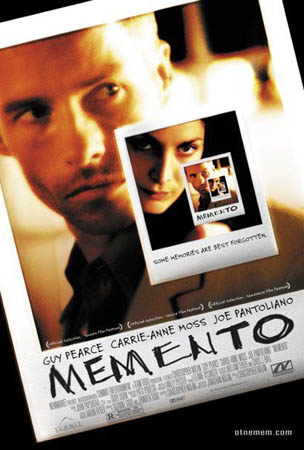 Momento |
Memento became an instant classic of the noir genre and an art house cult favorite when it was released in 2000. It follows the story of one Leonard Shelby, an insurance claims investigator, whose deductive skills are now aiding him in the search for the person who murdered his wife. There’s a problem, however, due to a head injury incurred during his wife’s murder, Leonard has lost the ability to form new memories.
For Leonard life is like just waking up to find his wife dead over and over again, having to figure out where he is and what he was doing. He has a system for keeping track of his life, carrying around photographs with notes in his pockets documenting where he lives and the people he knows. He uses tattoos to preserve the very important things. When Teddy, the person who seems to know him best, questions trusting someone’s life to this system, Leonard responds, “Memory’s unreliable… The cops don’t catch a killer by sitting around remembering stuff. They collect facts, they make notes, and they draw conclusions. Facts, not memories.”
Writer and director Christopher Nolan uses a clever technique to give the audience Leonard’s perspective, he tells the story in reverse. The film opens with the last event, Leonard killing the man who murdered his wife, and then moves backwards, scene by scene, unraveling the story of how he came to that conclusion. Like in all good Detective stories, nothing is what it seems.
All of the noir character archetypes are here. The psychotic killer, fem fatale, confidant, mobster, floozy, bad-cop, hard-boiled detective, and host of seedy peripheral characters all decorate the shadowy, dirty scenery. True to the noir genre, every character is working an angle. Most writers put their own twists on these character molds, but in “Memento” the twist is that the characters are rarely the archetype you think they are.
Have fun with the archetypes I have mentioned above. Each one makes an appearance in the film and then becomes another one as our unimpeded memories breaks through their facade. The fem fatale and the floozy, the bad-cop and the confidant, each one is also its opposite. What is Leonard then? He is not the hard-boiled detective his cool exterior leads us to believe, he is something else, and his true nature is hardest for us to determine because it is unknown even to himself.
The freshness of his last memory explains the obsessive way Leonard pursues revenge. This is his only purpose in life, to kill the man who murdered his wife. Beyond the noir mystery, the film also serves as a character study of Leonard Shelby and his condition. The more we learn about this man, the less we know.
“I have to believe that when my eyes are closed,” Leonard says, “the world’s still there.” Watching this protagonist, we know that it is not. His world vanishes every moment. If memory is all that we have, all our experiences that make us who we are, then when that is erased, so is our world.
See the film at least twice. Read the tattoos covering Leonard’s body. There are bits of wisdom he must have found in other episodes, a long history we know nothing about. Like the black and white scenes playing forward while the rest of the movie plays backward, soon to intersect. If you can overcome the confusion Leonard’s perspective produces and understand all the facts of the story, you will truly understand the crippling nature of Leonard’s condition.
See also: Insomnia (Same Director), Bladerunner (Same genre)